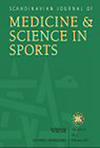使用潜在努力状态评估女性精英自行车运动员的月经周期或联合口服避孕药对训练负荷的影响
IF 3.5
2区 医学
Q1 SPORT SCIENCES
引用次数: 0
摘要
通过隐马尔可夫链模型(HMM)使用潜努力状态评估定期或不定期月经周期(MC)或联合口服避孕药(OC)对每次训练最大努力消耗时间的影响。为了确定 12 名法国精英自行车运动员在 30 个月内的潜在努力状态,使用了每秒记录心率(HR)和功率输出(PO)的 6303 次训练来训练 HMM。共分析了 101 个 MC/OC 完整周期。采用日历法估算出正常 MC 阶段(月经期、卵泡期、黄体期)。不规则的 MC 期分为月经期/无月经期,OC 期分为间歇期/服药期。确定了四种潜在的努力状态:高、中+、中-和低。以高强度为导向的训练课为重点,与估计的卵泡期(65.2%,p = 0.0009)和黄体期(55.4%,p = 0.024)相比,普通 MC 在月经期(34.5%)处于高强度努力状态的时间比例明显较低;与积极服药期(62.6%,p = 0.031)相比,OC 周期在停药期(43.7%)处于高强度努力状态的时间比例明显较低。在以高强度为导向的训练过程中,处于高强度状态的时间比例在正常周期中期几乎是正常周期的两倍,而在精英自行车运动员的月经期或服药间歇期则较低。这些发现依赖于在真实世界背景下对训练负荷的反复评估,并利用新型机器学习技术进行分析,客观量化了精英女子自行车运动员的内部和外部训练负荷。本文章由计算机程序翻译,如有差异,请以英文原文为准。
Impact of Menstrual Cycles or Combined Oral Contraception on Training Loads Assessed Using Latent Effort States in Female Elite Cyclists
To quantify the impact of the regular or irregular menstrual cycle (MC) or combined oral contraception (OC) on the time spent at the maximum effort exertion per training, assessed using latent effort states through a Hidden Markov chain Model (HMM). 6303 training sessions with heart rate (HR) and power output (PO) recorded every second were used to train HMM in order to determine latent effort states of 12 elite French cyclists followed up over 30 months. A total of 101 MC/OCs full cycles were analyzed. A calendar method was used to estimate regular MC phases (menstruation, estimated follicular phase, estimated luteal phase). Irregular MC was divided into menstruations/no menstruations and OC into break/active pill taking. Four latent effort states were identified: high, medium+, medium‐, and low. Focused on high intensity‐oriented training sessions, the proportion of time spent in high intensity effort state was significantly lower during menstruation (34.5%) compared to estimated follicular (65.2%, p = 0.0009) and luteal (55.4% p = 0.024) phases for regular MC, and during pills' break (43.7%) compared to active pill taking phase (62.6% p = 0.031) for OC cycles. During the high intensity‐oriented training sessions, the proportion of time spent in high effort state is almost twice higher in mid‐regular cycles whereas is lower during menstruation or pill's break in elite cyclists. These findings rely on repeated assessment of training loads in a real‐world context, analyzed using novel machine learning techniques that objectively quantify both internal and external training loads in elite female cyclists.
求助全文
通过发布文献求助,成功后即可免费获取论文全文。
去求助
来源期刊
CiteScore
7.90
自引率
4.90%
发文量
162
审稿时长
3 months
期刊介绍:
The Scandinavian Journal of Medicine & Science in Sports is a multidisciplinary journal published 12 times per year under the auspices of the Scandinavian Foundation of Medicine and Science in Sports.
It aims to publish high quality and impactful articles in the fields of orthopaedics, rehabilitation and sports medicine, exercise physiology and biochemistry, biomechanics and motor control, health and disease relating to sport, exercise and physical activity, as well as on the social and behavioural aspects of sport and exercise.

 求助内容:
求助内容: 应助结果提醒方式:
应助结果提醒方式:


